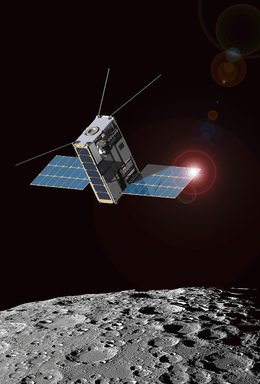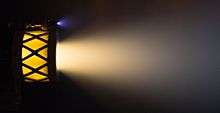Lunar IceCube
 Artist's rendering of the Lunar IceCube spacecraft | |
| Mission type | Lunar orbiter |
|---|---|
| Operator | NASA |
| Spacecraft properties | |
| Spacecraft | Lunar IceCube |
| Spacecraft type | CubeSat |
| Bus | 6U |
| Launch mass | ≈14 kg (31 lb) |
| Power | 2 deployable solar arrays |
| Start of mission | |
| Launch date | June 2020 |
| Rocket | SLS-1 |
| Orbital parameters | |
| Reference system | Polar |
| Periselene | 100 km (62 mi) |
| Inclination | ≈90° (polar) |
| Moon orbiter | |
| Transponders | |
| Band | X band |
Lunar IceCube is a planned NASA nanosatellite mission to prospect, locate, and estimate size and composition of water ice deposits on the Moon for future exploitation by robots or humans.[1] It will fly as a secondary payload mission on the first flight of the Space Launch System, Exploration Mission 1 (EM-1) scheduled to launch in 2020.
Overview
The lunar mission was designed by Morehead State University and its partners, the Busek Company, NASA Goddard Spaceflight Center, and The Catholic University of America (CUA).[2] It was selected in April 2015 by NASA's NextSTEP program ('Next Space Technologies for Exploration Partnerships') and awarded a contract worth up to $7.9 million for further development.[3][1]
The Lunar IceCube spacecraft will have a 6U CubeSat format, and a mass of about ≈14 kg (31 lb). It is one of thirteen CubeSats planned to be carried on board the maiden flight of the SLS EM-1 mission as secondary payloads in cis-lunar space, scheduled for 2020.[4] It will be deployed during lunar trajectory and will use an innovative electric RF ion engine to achieve lunar capture and the science orbit to allow the team to make systematic measurements of lunar water features from an orbit about 100 km (62 mi) above the lunar surface.[1] The Principal Investigator is Ben Malphrus, Director of the Space Science Center at Morehead State University.
History
NASA's Lunar Prospector, Clementine, Lunar Crater Observation and Sensing Satellite (LCROSS), the Lunar Reconnaissance Orbiter (LRO) and India's Chandrayaan-1 lunar orbiters and other missions, confirmed both water (H2O) and hydroxyl (—OH−) deposits at high latitudes on the lunar surface, indicating the presence of trace amounts of adsorbed or bound water are present,[5][6][7] but their instruments weren't optimized for fully or systematically characterizing the elements in the infrared wavelength bands ideal for detecting water.[2] These missions suggest that there might be enough ice water at polar regions to be used by future landed missions,[6][7] but the distribution is difficult to reconcile with thermal maps.[5]
Lunar prospecting missions are intended to pave the way toward incorporating use of space resources into mission architectures. NASA's planning for eventual human missions to Mars depends on tapping the local natural resources to make oxygen and propellant for launching the return ship back to Earth, and a lunar precursor mission is a convenient location to test such in situ resource utilization (ISRU) technology.[8]
Goals
The science goals are to investigate the distribution of water and other volatiles, as a function of time of day, latitude, and lunar soil composition.[3][1]
Payload

Lunar IceCube will include a version of the Broadband InfraRed Compact High Resolution Exploration Spectrometer (BIRCHES) instrument, developed by NASA's GSFC.[2] BIRCHES is a compact version of the volatile-seeking spectrometer instrument onbord the New Horizons Pluto flyby mission.[1]
Propulsion
The tiny CubeSat spacecraft will make use of a miniature electric RF ion engine system based on Busek's 3 centimeter RF ion thruster, also known as BIT-3.[1][9] It utilizes a solid iodine propellant and an inductively-coupled plasma system that produces 1.1 mN thrust and 2800 sec specific impulse from approximately 50W total input power.[9] It will also use this engine for capture into lunar orbit, and orbit adjustments.[1] It is estimated the spacecraft will take about 3 months to reach the Moon.[2]
Flight software
The flight software is being developed in SPARK/Ada by the Vermont Technical College CubeSat Lab[10]. SPARK/Ada has the lowest error rate of any computer language, important for the reliability and success of this complicated spacecraft. It is used in commercial and military aircraft, air traffic control and high speed trains. This is the second spacecraft using SPARK/Ada, the first being the Basic Low Earth Orbit CubeSat[11] also by the Vermont Tech CubeSat Lab, the only fully successful university CubeSat out of 12 on the NASA ELaNa IV Air Force ORS-3 launch[12].
See also
- The 13 CubeSats flying in the Exploration Mission 1
- Lunar Flashlight will map exposed water ice on the Moon
- Near-Earth Asteroid Scout by NASA is a solar sail spacecraft that will encounter a near-Earth asteroid
- BioSentinel is an astrobiology mission
- SkyFire by Lockheed Martin
- Lunar IceCube, by the Morehead State University
- CubeSat for Solar Particles (CuSP)
- Lunar Polar Hydrogen Mapper (LunaH-Map), designed by the Arizona State University
- EQUULEUS, submitted by JAXA and the University of Tokyo
- OMOTENASHI, submitted by JAXA, is a lunar lander
- ArgoMoon, designed by Argotec and coordinated by Italian Space Agency
- Cislunar Explorers, Cornell University, Ithaca, New York
- Earth Escape Explorer (CU-E3), University of Colorado Boulder
- Team Miles, by Fluid & Reason, LLC. Florida
References
- 1 2 3 4 5 6 7 "MSU's 'Deep Space Probe' selected by NASA for Lunar Mission". Morehead State University. 1 April 2015. Archived from the original on 26 May 2015. Retrieved 2015-05-26.
- 1 2 3 4 "NASA - Lunar IceCube to Take on Big Mission From Small Package". NASA. SpaceRef. 4 August 2015. Retrieved 2015-08-05.
- 1 2 "Lunar IceCube". Gunter's Space Page. 19 May 2015. Retrieved 2015-05-26.
- ↑ Clark, Stephen (28 April 2017). "NASA confirms first flight of Space Launch System will slip to 2019". Spaceflight Now. Retrieved 29 April 2017.
- 1 2 Cohen, Barbara A.; Sellar, R. G.; Staehle, R.; et al., eds. (2013). Lunar Flashlight: Mapping lunar surface volatiles using a CubeSat (PDF). Annual Meeting of the Lunar Exploration Analysis Group (2013). NASA - SSERVI.
- 1 2 "Lunar Flashlight". Solar System Exploration Research Virtual Institute. NASA. 2015. Retrieved 2015-05-23.
- 1 2 Wall, Mike (9 October 2014). "NASA Is Studying How to Mine the Moon for Water". Space.com. Retrieved 2015-05-23.
- ↑ "NASA Looking to Mine Water on the Moon and Mars". Solar System Exploration Research Virtual Institute. NASA. 2015. Retrieved 2015-05-23.
- 1 2 "Busek Ion Thrusters". 2015. Retrieved 2015-05-27.
- ↑ "CubeSat Laboratory, Software Components". 2017. Retrieved 2017-06-18.
- ↑ "CubeSat Laboratory, Basic Low Earth Orbit mission". 2017. Retrieved 2017-06-18.
- ↑ "Past ElaNa CubeSat Launches". 2017. Retrieved 2017-06-18.

